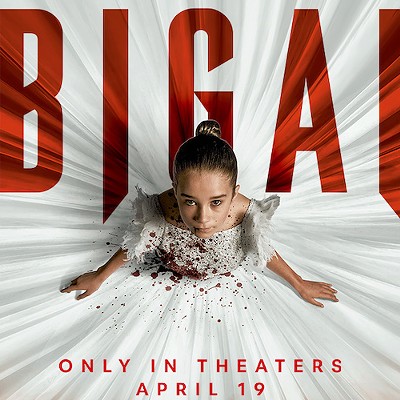Years later, he will describe the nightly missions of his adolescence as “military-esque,” complete with reconnaissance plans and escape strategies. In a way, what he and other youth were doing in the early ’80s was a kind of urban warfare. The fight, at least Figueroa’s personal one, was one of aesthetics, even if authorities didn’t see it that way.
“You want to leave your mark, leave something beautiful,” he says. “But you know in a heartbeat something could go wrong. You’re out there with a giant risk hanging over your head, but you’re fighting to leave your art.”
Such is the work life of a graffiti artist. But Figueroa, now better known as GONZO247, is no longer painting (or writing, as the act is referred to in the street-art community) his name behind convenience stores. He’s a commissioned artist, the man behind the sunburst of color that is the Houston Is Inspired mural downtown.
GONZO247 now works in broad daylight without the threat of arrest or detainment. Not that he’s ever experienced such reprimands. “Let’s just say when I was younger, I ran really fast,” he says jokingly. And he doesn’t have to worry about his work being painted over or destroyed. In the case of Houston Is Inspired, it will stay however long the Greater Houston Convention and Visitors Bureau, the organization that commissioned the piece, wants it up.
That means a lot for an artist who has always understood his work to be ephemeral. “It’s instilled in every graffiti artist that their work is temporary and nothing is permanent,” he says. “You knew that you created a piece, that it once existed, and hoped for the best, because you also know that one day, the city or the property owner or another artist would paint over it.”
The founder of the now legendary video magazine Aerosol Warfare and its accompanying gallery on Jefferson, GONZO247 has spent much of his career in Houston advocating for street art as much as he has creating it.
And he’s the man behind the first graffiti museum in the country: The Graffiti and Street Art Museum of Texas. He’s at work organizing and developing the new 501(c)(3) nonprofit organization, which in many ways is the culmination of two and half decades devoted to validating a form of expression often associated with gangs and illegal activities.
Currently housed at Aerosol Warfare before it opens at its new, as yet undisclosed location in January, the GASAM isn’t just another art institution. It’s the first of its kind, the only museum in the nation dedicated to graffiti and street art. “We’re not the East Coast or West Coast. We’re the Third Coast, right in the middle of the country,” GONZO247 explains. “We’re positioned in a unique spot, where we can’t be biased to either coast [where the art form took hold in the ’70s]. Major entities from all over the world have contacted us to ask what they can do to support us.”
The GASAM will be a fully curated institution with major programming to go along with it. “The idea for a graffiti museum isn’t a new one,” GONZO247 says. “The streets themselves have always been the natural museums for graffiti.”
GONZO247 cites the artwork of cavemen and the Romans as graffiti that has endured for centuries, but a person doesn’t need to cross the ocean to find examples that have weathered the years and sparked the imagination of its contemporaries. Crossing the tracks is good enough.
*****
Mario Enrique Figueroa Jr. spent much of his youth traveling up and down Lockwood and Canal visiting extended family who lived in the neighborhood. His parents immigrated from Mexico along with his aunts, uncles and grandparents, who had a plethora of brothers and sisters of their own.“It was this tribe, and we all lived here in the East End. “I spent my time visiting family, because that’s what you did, and at least two or three times a week, I was passing The Rebirth of Our Nationality on Canal Street,” he explains, referring to the iconic mural by Leo Tanguma that was created during the height of the Chicano movement in 1973. “I didn’t understand it completely. If anything, it was somewhat scary, and when you’re that age, you really don’t understand the imagery and take things too literally. What really affected me was the sheer scale of the wall. I thought, man, it would be awesome to do something that big.”
Growing up, Figueroa was a creative kid. He would draw and sketch everything from hot rods to monsters to dinosaurs, but never really had a focus to channel his artistic energy. And then sometime in the early ’80s, he found hip-hop. Graffiti art is one of the four keystone elements of hip-hop culture along with the crafts of the emcee, the DJ and the b-boy. But it wasn’t the visual component that caught the imagination of the future GONZO247.
“I got into the music first, because that was the most accessible to me. By listening to the music, I started to understand the emcee turntables. Little by little, the information came trickling through. It’s like going to church and getting your sacraments. The final stage was graffiti.”
The rise of the rap and hip-hop counterculture preceded the days of the Internet by a good margin, so connections to the graffiti world came through limited means. “My only access was by chance,” he explains. “You’d buy a cassette tape and see some cool stuff inside. Well, I fell in love. I finally felt connected to something creative. I knew this was going to be the vehicle to release my creative energy.”
It wasn’t long before Figueroa began operating under the moniker GONZO247. “For a while, I developed this tag, which was really my government name that you couldn’t figure out. One day I was working on something when I stumbled across the definition of the word ‘gonzo,’ which I didn’t know before. I thought gonzo was a Muppet, but it’s actually a word.” (“Gonzo” can be used as both a noun and an adjective to refer to eccentricity and craziness in commentary.) The numerical element came from keeping within the tradition of graffiti writer signatures on the East and West Coasts to differentiate between artists with the same first names. The writer would add his street or apartment number to the tag, so it became a sort of last name for the signature.
“I wanted to keep that tradition, and I thought ‘24/7’ sounded cool. That lasted until the ’90s.” He cites a ubiquitous Walmart advertising campaign that touted the chain’s 24/7 hours of operation as a decisive factor for dropping the numbers. “I ran without the numbers for a while, but I honestly felt there was something missing, so I brought them back. Now it’s just two-four-seven. It opens up the interpretation to the numbers and gives me the opportunity to come up with a creative answer when people ask about them.”
With a persona established, then came the conundrum of figuring out how GONZO247 could make a living as an artist, which was only compounded by the lack of respect graffiti had at the time. Another problem was that there wasn’t a centralized community. “The first time I saw his work was at [Houston’s] Red Square,” says longtime colleague David Flores, a.k.a. Skeez181. “There were some storage boxes on the side of the club and they were done up with graffiti letters with super-bright colors, and I thought, ‘Wow, how could anyone do this?’ This was in 1990, and I didn’t know he was spray painting like this because I was working on the other side of the city. At the time, based on the neighborhood you lived in, some places were more territorial than others. Sometimes you’d get crossed out because there were a lot of street politics,” he says, referring to the act of having one’s art defaced.
Individual street artists from around the city began to find each other downtown. However, the work itself wasn’t embraced by the public or the beacons of power in the art world. “Before Google, I went to the Yellow Pages and looked up galleries and museums. I would walk up to these places, and that’s when I found out the hard way what people thought,” GONZO247 says. “They’d tell me, ‘You can’t just show up here; graffiti is illegal. It’s gang-related.’ As soon as people saw a spray can, it was, ‘No, I don’t want to do this.’”
That’s when he realized that his career would have to be twofold. Not only would GONZO247 have to be a creator, he’d also have to be an educator and ambassador for the art form. “People fear the unknown,” he explains. “I thought that I could educate people on what this is, then maybe it might change the perception of what’s going on, and that might change something.”
The education process started with himself first. “History is important to him,” says GONZO247’s wife, Carolyn Casey-Figueroa. “He was in Houston 25 years ago communicating to other out-of-state and international graffiti artists using a pen-pal system. He wrote letters, mailed them and hoped he would get a response back, and he did. He formed many relationships early on using this system.” His correspondences became the basis for Aerosol Warfare.
“Through detective work, I would connect with a lot of really great artists. I would send videos of me and my friends doing graffiti, and then sometimes I’d get a tape back,” GONZO247 says. The tapes came in from both coasts and even as far away as Australia. There would be b-boy footage and emcee footage, a full record of international hip-hop culture developing in real time delivered to Houston, albeit in raw, homemade form. From these correspondences, he got the idea to create video compilations of hip-hop and graffiti in action. “It was super play, pause, record, that kind of thing,” he recalls.
When he sent a copy to a friend in New York City, he was encouraged to start selling the videos. He set up a post office box, and cash came in from subscribers in every part of the world. He knew Aerosol Warfare was leaving its mark when he learned that the videos were being bootlegged in Singapore. The crew, which at the time included graffiti writer Merge 360, then made the transition to gallery-style exhibitions around 1992.
“I was running a gallery named REF Studios in the Montrose neighborhood in Houston, and invited a student of mine to invite his graffiti artist friends around the city for an exhibition because I had a giant wall of cinderblocks along the side of my property,” says Richard Fluhr, a longtime champion of GONZO247’s work. “He and seven other crews worked together on a huge mural that ended up getting lots of press. I was sure not to have any of the real names because we were expecting the police, and I encouraged the artists to make smaller works for the interior of the gallery so they could make a little money to start off a more legitimate career. People interested in the artists’ work were put in touch directly with the artists for potential sales or murals.”
The arts community took notice and, over the next several years, Aerosol Warfare spent much of its time curating and producing graffiti art shows. GONZO247 then started to collaborate with musician Christian Azul to stage what he calls art experiences, in which his crew would acquire warehouse spaces and fill the interiors with wall-to-wall graffiti. These spaces would then serve as backdrops for underground parties in which the audience would be engulfed by the artwork. “We started doing these series of exhibitions where we just named the exhibition a color,” GONZO247 recalls. “And everything was graffiti and monochromatic. Towards the end of the series, people would show up wearing that specific color, and in a way they would become part of the installation.”
Aerosol Warfare has brought some of the icons of graffiti to Houston with the intention of showing young people that art can indeed be a valid career choice. “In the past, we’ve worked with Shepard Fairey, who has always been in my eyes the type of artist that you should aspire to be,” says GONZO247. The gallery has also brought in Futura 2000, known for his work in the train yards of New York City, as well as SEEN, considered by many to be the godfather of graffiti. It was also able to bring in an exhibition of the now-deceased Rammellzee, one of the founders of modern-day graffiti.
The communal aspect of his art isn’t just a byproduct. It’s an intention. “He loves the social aspect when creating on the streets,” says his wife, Carolyn. “He just absolutely loves to be around and interact with people, whether friends or strangers. The colors and energy of his work match his friendly personality and optimistic take on life, which I believe draws people in to have a good time.”
“I feel like I’m a colorful person and that I have colorful energy,” says GONZO247. “Colors exist so that life can exist. I try to embed that when I paint, so that some of that reflects back to the viewer. Maybe they’re having a bad day, so maybe when they see the wall, they’ll feel just a little bit better.”
*****
In 2015, it’s clear that GONZO247’s efforts have been far from fruitless. Street art can be found in museums and private art collections, and is being commissioned by civic authorities as both public art installations and beautification efforts. There are still naysayers, but they’re in the clear minority. Gina Miller, public relations and programs manager of the Houston Museum District Association, notes that while some graffiti has historically been used for nefarious purposes, the overwhelming majority of artists working in the medium — and their collective creative output — are far from criminal. “Each neighborhood has a story to tell, and I think street art could be considered urban place-making,” she says. “A visual marker to help identify and tell the story of each district and neighborhood. The Galleria has the silver orbs at each intersection; the rest of us have street art. Honestly, I think sometimes it can be the most vibrant art in otherwise bleak and desolate landscapes.”
Graffiti has also gained mainstream acceptance thanks to corporate advertising that started to use the elements of hip-hop in the ’90s to appeal to younger audiences. “The evolution of graffiti owes a lot of thanks to pop culture,” says Skeez181. “You have your soda pop companies promoting hip-hop and graffiti with a message of having a good time. That’s how it went from an underground street element to what it is today. You have your Banksys now, and Mr. Brainwash, and Shepard Fairey, using the Simpsons or Pepsi or whatever.”
Now GONZO247 and Houston are on the cusp of street-art history with the opening of the GASAM. Programming in the near and distant future includes a permanent exhibition, workshops, graffiti tours, outreach programming, temporary exhibits featuring national and international artists, and film screenings.
Miller foresees a strong working relationship between the GASAM and the rest of Houston’s celebrated Museum District. “We have already seen collaborations of incorporating GONZO’s work all around Houston. The Contemporary Arts Museum Houston and The Menil Collection, through a collaboration with Aurora Picture Show, have been doing projects with him for a while now. More recently, he’s been part of the gorilla habitat campaign at the Zoo, the newly renovated How Does It Work? exhibit at The Children’s Museum of Houston, not to mention the Parliament of Owls show at DiverseWorks. Ultimately, Houstonians love to rally for their hometown champions.”
GONZO247 is quick to point out that the GASAM isn’t his attempt to monopolize the art form he loves so much. “This whole thing is not to say that the museum is an authority. We’re not trying to claim this is the final word. It’s not about me having the say of what happens. For years, the original museums were the train yards of New York, and that’s where all the masterpieces lived. This is about education and giving people a place to learn.”
The museum is also about nurturing the course of graffiti into the future. “His dream continues to see art and artists implemented into grade schools and college-level curriculums to teach the history and techniques to emerging artists and future educators,” says Carolyn.
Houston is more than willing to help the cause. As GONZO247 notes, the city is getting younger, the gatekeepers who told him “no” 25 years ago are being replaced by young professionals who have grown up with graffiti as part of mainstream culture. “It’s gotten to a point that, through education, graffiti and street art have been allowed to grow,” says GONZO 247. Growth is necessary for an art form that has so much to say and speaks for so many people.
“Graffiti is the final frontier of free speech,” he says. “How much more brazen can you get? People act so tough about whatever cause on the Internet and in the safety of their own home, but if you feel that strongly, if you really mean it, grab a can of paint, risk your life and freedom and write it on a wall and write it on a billboard. If you really mean that, write it on the side of the building, and maybe then I’ll be able to respect you.”





